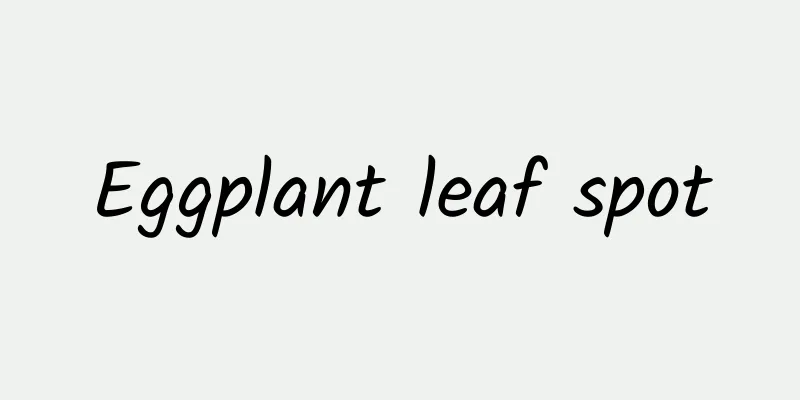Eggplant leaf spot

|
Eggplant leaf spot disease will seriously affect the growth and yield of eggplant, so how to avoid this pest? Disease symptomsIt mainly harms leaves, petioles, stems and fruits. Small water-soaked round spots initially appear on the back of leaves, and then spread to the front of leaves or fruits. The leaf spots are round or nearly round, with dark brown edges, grayish white in the middle, slightly concave, and the size of the spots is 1.5 to 4.5 mm. In the later stage, many small black dots are scattered on the spots, which are the conidiophores of the pathogen. Edit this section Pathogen characteristics The conidiophores are spherical or oblate, black in color, initially buried under the host epidermis, then partially break through the epidermis and appear as small black dots. The shell wall is relatively loose, with part of the mycelium often adhering to the outside of the wall, measuring 49-122.5×49-128.6 microns. The outer wall of the opening of the conidiophore is relatively thin, with a diameter of 7.5-57.5 microns. Conidia are born at the bottom of the oblate spherical apparatus in large numbers, escaping from the opening after maturity. Individual spores are colorless, needle-shaped, straight or slightly curved, with 3-9 septa, measuring 45-90×2.3-2.8 microns. Mode of transmissionThe hyphae and conidiophores overwinter on diseased remains, perennial Solanaceae weeds or attached to seeds, becoming the source of infection at the beginning of the following year. Conditions of diseaseGenerally, after the conidiophore absorbs water, the colloid inside the conidiophore dissolves, and the conidia escape, spread by wind and rain or splashed onto the eggplant plant by rain, and invade from the stomata, and then produce conidiophores and conidia in the diseased part to expand and cause harm. The optimum temperature for the development of the pathogen is 22-26℃, and it is poorly developed below 12℃ and above 27.8℃. Conidia are lethal after 10 minutes at 52℃. High humidity is conducive to the overflow of conidia from the device, and the suitable relative humidity is 92%-94%. If the humidity is not reached, the disease will not occur. In case of heavy rain, especially after the rain, the sun turns clear, the eggplant grows weakly, and there is insufficient fertilizer, the disease is prone to occur. The temperature is 20-25℃, and the incubation period is about 4 days. Prevention and treatment methodsBasic Methods (1) The seedbed should be new soil or a sunny bed or plot that has not been used to grow Solanaceae vegetables within two years. The planting field should be rotated every 3 to 4 years. (2) Save seeds from disease-free plants and soak them in 52°C warm water for 30 minutes. Take them out, dry them, and germinate them before sowing. (3) Select disease-resistant varieties. (4) Cultivate on high ridges, plant at an appropriate density, and pay attention to field drainage and humidity reduction. Pharmaceutical Method(1) Strengthen field management, use fertilizers rationally, increase the application of phosphorus and potassium fertilizers, spray 4000 times diluted multi-effect fertilizer or 6000-8000 times diluted 1.4% sodium nitrate solution to improve disease resistance; avoid over-crowding, keep the field well ventilated and light-permeable and the ground dry; bury or burn diseased and residual materials after harvesting. (2) At the early stage of the disease, spray 400-500 times of 64% antimicrobial WP or 500 times of 58% metalaxyl·manganese zinc WP, 800 times of 80% xinwansheng WP, 600 times of 75% chlorothalonil WP, 50% mixed sulfur suspension or 800 times of 60% anti-mold treasure No. 2 water-soluble powder, 80-100 times of 27% high lipid film emulsion, once every 10 days or so, and continue to prevent and control 2-3 times depending on the disease condition. Stop spraying chlorothalonil 7 days before harvest, and stop using other fungicides 3 days before harvest. |
<<: Tomato pork ribs soup steps
>>: How to make duck and winter melon soup at home
Recommend
What is the Indian Festival Society like? Indian Festival Society reviews and website information
What is the Society of Festivals of India website?...
How to make Zhongjing mushroom sauce? The efficacy of Zhongjing mushroom sauce
Zhongjing Mushroom Sauce is a very popular sauce ...
The efficacy and function of Wuyi Mountain Red Mushroom Wuyi Mountain Red Mushroom cooking steps tutorial
Wuyi Mountain Red Mushroom belongs to the wood-re...
Mentor Graphics - Mentor Graphics Reviews and Website Information
Mentor Graphics_What is Mentor Graphics? Mentor Gr...
Is it good to eat pine nuts? Who is not suitable to eat pine nuts?
Pine nuts, also known as pine nuts, are a highly ...
How is Unisys? Unisys system review and website information
Unisys_What is the website of Unisys? Unisys is an...
The efficacy and function of Fuji apple
Fuji apple is one of the many apple varieties. It...
What is Cirque du Soleil like? Cirque du Soleil reviews and website information
What is the website of Cirque du Soleil? Cirque du...
Sweet porridge
I believe that you don’t know much about sweet po...
Why can't you eat ginger at night? What are the harms of eating ginger at night?
Ginger is a common food ingredient with certain h...
What is the Australian Associated Press like? Australian Associated Press reviews and website information
What is the Australian Associated Press website? T...
The nutritional value of winter melon
I believe we have all eaten winter melon, which i...
Ingredients and steps for mushroom meatball porridge
Mushroom-flavored meatball porridge can strengthe...
Who can't eat white lentils? What are the nutritional values of white lentils?
White lentil is a special food and medicine. It c...
How to distinguish the authenticity of 92% aloe vera gel
Korean Nature Paradise 92% Aloe Vera Gel is very ...









